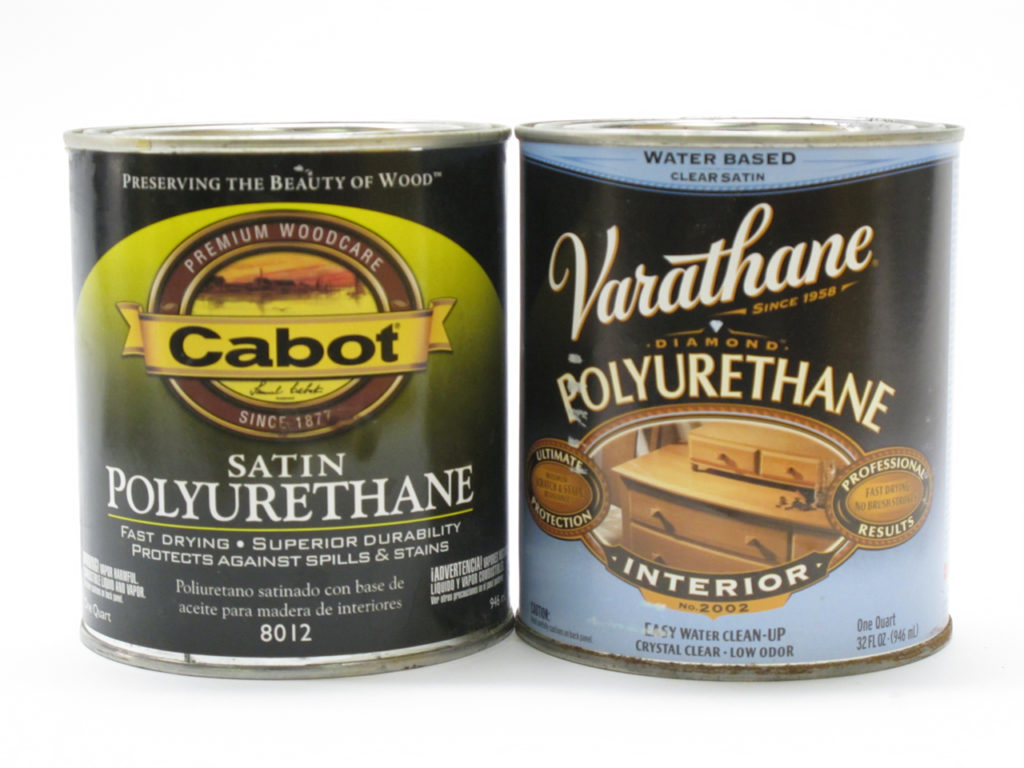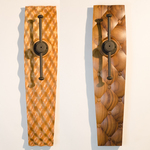We may receive a commission when you use our affiliate links. However, this does not impact our recommendations.
We are offering a spectacular collection of products by Bob Flexner at shopwoodworking.com right now. Check it out here, Finishing with Bob Flexner Collection.

Oil-based and water-based polyurethane are almost always the best choices of finish to use on wood floors.
The two key considerations for choosing a wood floor finish are resistance to scratches and the large surface to be covered.
To stand up to abuse, you need a very durable, scratch-resistant, finish, and to avoid filling the room with overspray that will settle and stick to everything, including the finish, you need one that dries slowly enough so it can be applied by hand. The two best choices that meet both of these criteria are oil-based polyurethane and water-based polyurethane.
Oil-based polyurethane is more durable than water-based, but it has a strong odor that hangs around for several days, and it has a slight orange coloring (usually referred to as “yellowing”). Water-based polyurethane has very little odor, almost no coloring, and it’s much easier to clean from brushes and other tools. Water-based polyurethane also dries relatively rapidly. So you have to work much faster, being sure to keep a “wet edge” so overlaps don’t show. But the faster drying makes it possible to apply two or three coats in a day.

Water-based polyurethane (left) adds very little coloring to wood. Oil-based polyurethane (right) adds a slightly yellow/orange coloring.
Oil-based polyurethane is the best choice if the color, odor and clean-up aren’t problems. Water-based polyurethane is the best choice if you want to preserve the color of very light woods or white pickling, or if odor is a problem. You may be able to buy a more durable, two-part, water-based polyurethane from a flooring-supply store. Be sure to check on the toxicity of the product and the safety precautions you should take.
Use a large brush, sponge mop or lamb’s wool pad attached to a pole to apply either type of polyurethane. For water-based polyurethane a paint pad attached to a pole also works well. A paint tray provides a convenient reservoir to work from with both finishes.
Some people prefer finishing wood floors with oil finishes or a wiping varnish. Be aware that oil finishes have no build and are not scratch resistant. So you’ll probably get scratches and wear and have to recoat often. Wiping varnish can be just as scratch resistant as full-strength polyurethane, but you may have to apply more coats.
– Bob Flexner
We are offering a spectacular collection of products by Bob Flexner at shopwoodworking.com right now. Check it out here, Finishing with Bob Flexner Collection.
Here are some supplies and tools we find essential in our everyday work around the shop. We may receive a commission from sales referred by our links; however, we have carefully selected these products for their usefulness and quality.









The wood flooring in our 17 yr old home is 2″ wide oak strips with slightly chamfered edges and has a factory finish in “gunstock” color. The finish remains in excellent shape and does not need refinishing because of wear. However when we recently sent out some area rugs for cleaning, it was quite shocking to see how faded the “gunstock” color had become in some places. This was only in areas that were exposed to light coming thru windows, even on the north side of the house. Is there a finish that we could apply to restore the faded color without needing to sand the whole floor area and refinish the entire area? WIll sanding destroy the chamfered edges? Could we use Tinted poly or even tinted floor wax to get a few more years from the floors before doing a full refinish?
I remember when Varathane water based floor poly first came out. It had the option of using a catalyst to make it very hard. For some reason, it did not catch on.
One advantage I have experienced using the water based finish is how incredibly easy repairs and recoats are. A very thorough cleaning was all that was necessary. The act of getting on your hands and knees and scrubbing is not pleasant, but it was enough to get off all visible dirt and dust, and in the process provided enough tooth that adhesion was no problem. It really wasn’t much different from doing an old fashioned waxing job.
I will never do polyurethane on floors again. I’ve been restoring a house built in 1871 and I did the kitchen and main staircase with Tung oil and had a floor finishing company do the rest of the house in polyurethane. I waxed the Tung oil finished areas before moving in.
The Tung oil is in the most abused areas of the house and you can’t tell that months of construction, a move in, two huge dogs and a two year old boy ever happened. The polyurethane already looks worn out in the corridors, breakfast room and living room.
There is a catch though. I was able to spend the tremendous amount of time necessary to apply the Tung oil and wait for it to fully dry before the next coat and to close those areas off from traffic entirely for nearly two months. It took about a week to finish the kitchen floors and four days to do the main staircase.
But it was worth it. The Tung oil floors look incredible and the polyurethane looks like a huge waste of money. Which is exactly what it was.
http://glitsa.com/professionals/products/ Two coats of Bacca floor seal and one coat of Gold Seal, will last twice as long as any polyurethane product on the market. Twice as long. 12 -14 years. Try it if you dare.
Bob,
One of the best products I have ever come across for finishing wood is a product called Rubio Monocoat.
It was interesting to use an oil based coating system that dried fast and had almost no odor. The other interesting part is the versatility I found in coring and/or highlighting with color. Back in the day when someone pastels like white you can almost had to talk them out of it. Not with this stuff.
So far the durability has been awesome as well. No worrying about lap marks with this product either.
I did a wood floor in my wife’s home office with 4 widths and 2 species each Oak and hickory.
Came out better thAn expected.
Your thoughts on this are appreciated.
I’ve had people refinish my floors in different houses over the years and always used poly. I have an ash floor in my shop and used a heavy duty poly finish similar to Gymseal on it but found that rolling my heavy planer and joiner around left indentations. When I finished the mixed Sugar and Red Maple floor in my house, I used an oil finish. Having a dog who often entertained boisterous friends, I was thrilled to find that I could only find minute scratches in the maple whereas the floors I’ve done in the past with poly were rife with scratches from dog toe nails. It’s true that I probably should re-oil soon, but it’s been over 9 years and by washing periodically with Dergos, an oil based soap, and the floor looks pretty nice. I do have a few areas that have red wine stains but even these seem to fade over time. Certainly not the answer for pine unless you are looking to achieve the “distressed” look more quickly!
Have you had any experience with the high solid oi floor wax(osmo is one brand)? Information is scarce. I suspect a urathane of some kind. Everyone raves about them but I suspect most is marketing BS.